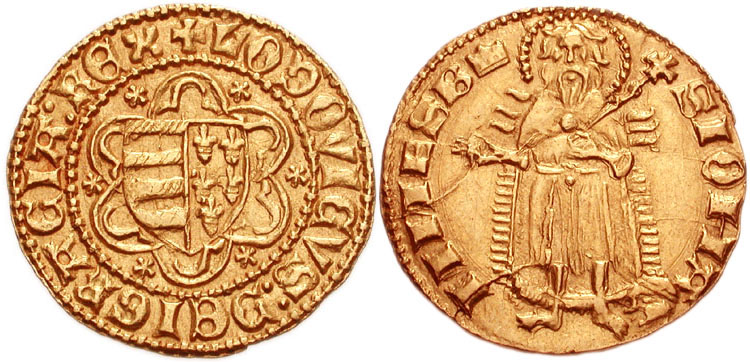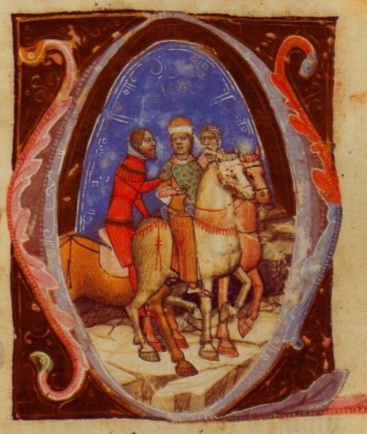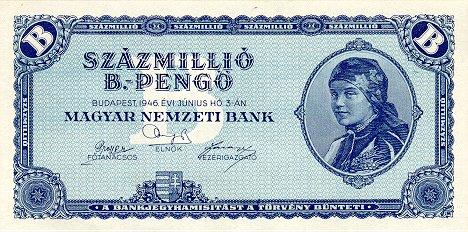|
Hungarian Forint
The forint (sign Ft; code HUF) is the currency of Hungary. It was formerly divided into 100 fillér, but fillér coins are no longer in circulation. The introduction of the forint on 1 August 1946 was a crucial step in the post-World War II stabilisation of the Hungarian economy, and the currency remained relatively stable until the 1980s. Transition to a market economy in the early 1990s adversely affected the value of the forint; inflation peaked at 35% in 1991. Between 2001 and 2022, inflation was in single digits, and the forint has been declared fully convertible. In May 2022, inflation reached 10.7% amid the war in Ukraine and economic uncertainty. As a member of the European Union, the long-term aim of the Hungarian government may be to replace the forint with the euro, although under the current government there is no target date for adopting the euro. History The forint's name comes from the city of Florence, where gold coins called '' fiorino d'oro'' were minted fro ... [...More Info...] [...Related Items...] OR: [Wikipedia] [Google] [Baidu] |
Hungarian National Bank
The Hungarian National Bank ( hu, Magyar Nemzeti Bank (MNB)) is the central bank of Hungary and as such part of the European System of Central Banks (ESCB). The Hungarian National Bank was established in 1924 and succeeded the Royal Hungarian State Bank, which introduced the Hungarian forint on 1 August 1946. The Hungarian National Bank lays special emphasis on its international relations and on participation in the professional forums of international economic institutions and financial organisations (EU, IMF, OECD, BIS). Its principal aim is price stability, but it is also responsible for issuing the national currency, the forint, controlling the money in circulation, setting the Central Bank base rate, publishing official exchange rates, and managing the foreign-exchange reserves and gold to influence exchange rates. Operations The Governor of the Hungarian National Bank is appointed by the President of Hungary at the proposal of the Prime Minister for a six-year term. The ... [...More Info...] [...Related Items...] OR: [Wikipedia] [Google] [Baidu] |
Charles I Of Hungary
Charles I, also known as Charles Robert ( hu, Károly Róbert; hr, Karlo Robert; sk, Karol Róbert; 128816 July 1342) was King of Hungary and Croatia from 1308 to his death. He was a member of the Capetian House of Anjou and the only son of Charles Martel, Prince of Salerno. His father was the eldest son of Charles II of Naples and Mary of Hungary. Mary laid claim to Hungary after her brother, Ladislaus IV of Hungary, died in 1290, but the Hungarian prelates and lords elected her cousin, Andrew III, king. Instead of abandoning her claim to Hungary, she transferred it to her son, Charles Martel, and after his death in 1295, to her grandson, Charles. On the other hand, her husband, Charles II of Naples, made their third son, Robert, heir to the Kingdom of Naples, thus disinheriting Charles. Charles came to the Kingdom of Hungary upon the invitation of an influential Croatian lord, Paul Šubić, in August 1300. Andrew III died on 14 January 1301, and within four mon ... [...More Info...] [...Related Items...] OR: [Wikipedia] [Google] [Baidu] |
Paper Money Of The Hungarian Pengő
Hungarian pengő paper money ( hu, pengő papírpénz) was part of the physical form of Hungary's historical currency, the Hungarian pengő. Paper money usually meant banknotes, which were issued (either in fact or in name) by the Hungarian National Bank. Later – during and after World War II – other types of paper money appeared, including emergency money, bonds and savings certificates. Initially, paper money was designed abroad, and printed using simple methods. Later, more advanced techniques were used, creating banknotes which reflected stability. After the war, in parallel with their loss in value, the quality of banknotes decreased. Finally, not even serial numbers were printed on the notes. Banknotes First series (1926) The first series of pengő banknotes were printed in 1926 in the following denominations: 5 P, 10 P, 20 P, 50 P, and 100 P. All these banknotes were designed by Ferenc Helbing. Due to the poor printing technology (offset printing) counterfeits appeared ... [...More Info...] [...Related Items...] OR: [Wikipedia] [Google] [Baidu] |
Hungarian Communist Party
The Hungarian Communist Party ( hu, Magyar Kommunista Párt, abbr. MKP), known earlier as the Party of Communists in Hungary ( hu, Kommunisták Magyarországi Pártja, abbr. KMP), was a communist party in Hungary that existed during the interwar period and briefly after World War II. It was founded on November 24, 1918, as Party of Communists in Hungary, and was in power between March and August 1919 when Béla Kun ran the short-lived Hungarian Soviet Republic. The communist government was later overthrown by the Romanian Army, Kun was exiled to Vienna and later he including many other communists moved to Moscow and during those years membership was becoming smaller every year. During World War II the party changed its name to Peace Party but only a year later in 1944, they embraced a new name which they will hold until 1948. After the war, they regained power and their membership rose up quickly which led to Mátyás Rákosi suppressing other parties in the country besides the so ... [...More Info...] [...Related Items...] OR: [Wikipedia] [Google] [Baidu] |
Social Democratic Party Of Hungary
The Social Democratic Party of Hungary ( hu, Magyarországi Szociáldemokrata Párt, MSZDP) is a social democratic political party in Hungary. Historically, the party was dissolved during the occupation of Hungary by Nazi Germany (1944–1945) and the communist period of Hungary from 1948 to 1989, after being forced into a merger with the Communist Party. It worked legally for a short time during the Revolution of 1956. It was a government party as a part of the Károlyi Government (1918–1919), Berinkey Government, Peidl Government (1919), Interim National Assembly (1944–1945) and Dinnyés Government (1947–1948). It was reorganized after Hungary's transition from communism in 1989. MSZDP used to be a member of the Socialist International and the Party of European Socialists until 2020, when it was delisted from both due to inactivity. Overview Hungary as part of Austria-Hungary: *1868–1890 The ''General Workers Association'' (''Általános Munkásegylet'') ... [...More Info...] [...Related Items...] OR: [Wikipedia] [Google] [Baidu] |
1945 Hungarian Parliamentary Election
Parliamentary elections were held in Hungary on 4 November 1945. Dieter Nohlen & Philip Stöver (2010) ''Elections in Europe: A data handbook'', p899 They came at a turbulent moment in the country's history: World War II had had a devastating impact; the Soviet Union was occupying it, with the Hungarian Communist Party growing in numbers; a land reform that March had radically altered the property structure; and inflation was rampant. In what is generally reckoned as the first relatively free election in the country's history, the Independent Smallholders Party won a sweeping victory. However, the Smallholders' gains were gradually whittled away by Communist salami tactics, fulfilling the prediction of Communist leader Mátyás Rákosi that the defeat would "not play an important role in Communist plans". Background Elections (which had not taken place since 1939) were required by the Yalta Agreement; moreover, the revolutionary social and political changes of 1945 were effecte ... [...More Info...] [...Related Items...] OR: [Wikipedia] [Google] [Baidu] |
Independent Smallholders' Party
The Independent Smallholders, Agrarian Workers and Civic Party ( hu, Független Kisgazda-, Földmunkás- és Polgári Párt), known mostly by its acronym FKgP or its shortened form Independent Smallholders' Party ( hu, Független Kisgazdapárt), is a political party in Hungary. Since the 2002 parliamentary elections, the party has won no seats. History Founded on 12 October 1930, the party was one of the largest anti-fascist opposition parties in the 1930s and during World War II. Representing the interests of landed peasants along with some poor peasants and urban middle class, it advocated for land reform and democratization. Its members opposed Hungary's participation in World War II, giving anti-fascist speeches in Parliament and leading rallies as late as 1943. During the German occupation of Hungary, its members took part in the clandestine anti-fascist resistance movement, and played a major role in the provisional government established in the Soviet-occupied zone of ... [...More Info...] [...Related Items...] OR: [Wikipedia] [Google] [Baidu] |
United States
The United States of America (U.S.A. or USA), commonly known as the United States (U.S. or US) or America, is a country primarily located in North America. It consists of 50 states, a federal district, five major unincorporated territories, nine Minor Outlying Islands, and 326 Indian reservations. The United States is also in free association with three Pacific Island sovereign states: the Federated States of Micronesia, the Marshall Islands, and the Republic of Palau. It is the world's third-largest country by both land and total area. It shares land borders with Canada to its north and with Mexico to its south and has maritime borders with the Bahamas, Cuba, Russia, and other nations. With a population of over 333 million, it is the most populous country in the Americas and the third most populous in the world. The national capital of the United States is Washington, D.C. and its most populous city and principal financial center is New York City. Paleo-Americ ... [...More Info...] [...Related Items...] OR: [Wikipedia] [Google] [Baidu] |
USSR
The Soviet Union,. officially the Union of Soviet Socialist Republics. (USSR),. was a transcontinental country that spanned much of Eurasia from 1922 to 1991. A flagship communist state, it was nominally a federal union of fifteen national republics; in practice, both its government and its economy were highly centralized until its final years. It was a one-party state governed by the Communist Party of the Soviet Union, with the city of Moscow serving as its capital as well as that of its largest and most populous republic: the Russian SFSR. Other major cities included Leningrad (Russian SFSR), Kiev ( Ukrainian SSR), Minsk ( Byelorussian SSR), Tashkent (Uzbek SSR), Alma-Ata (Kazakh SSR), and Novosibirsk (Russian SFSR). It was the largest country in the world, covering over and spanning eleven time zones. The country's roots lay in the October Revolution of 1917, when the Bolsheviks, under the leadership of Vladimir Lenin, overthrew the Russian Provisional Gove ... [...More Info...] [...Related Items...] OR: [Wikipedia] [Google] [Baidu] |
Hyperinflation
In economics, hyperinflation is a very high and typically accelerating inflation. It quickly erodes the real value of the local currency, as the prices of all goods increase. This causes people to minimize their holdings in that currency as they usually switch to more stable foreign currencies. When measured in stable foreign currencies, prices typically remain stable. Unlike low inflation, where the process of rising prices is protracted and not generally noticeable except by studying past market prices, hyperinflation sees a rapid and continuing increase in nominal prices, the nominal cost of goods, and in the supply of currency. Typically, however, the general price level rises even more rapidly than the money supply as people try ridding themselves of the devaluing currency as quickly as possible. As this happens, the real stock of money (i.e., the amount of circulating money divided by the price level) decreases considerably.Bernholz, Peter 2003, chapter 5.3 Almost all ... [...More Info...] [...Related Items...] OR: [Wikipedia] [Google] [Baidu] |
Hungarian Pengő
The pengő (; sometimes written as ''pengo'' or ''pengoe'' in English) was the currency of Kingdom of Hungary (1920–46), Hungary between 1 January 1927, when it replaced the Hungarian korona, korona, and 31 July 1946, when it was replaced by the Hungarian forint, forint. The pengő was subdivided into 100 fillér. Although the introduction of the pengő was part of a post-World War I stabilisation program, the currency survived for only 20 years and experienced the most serious case of hyperinflation ever recorded. Name The Hungarian participle ''pengő'' means 'ringing' (which in turn derives from the verb ''peng'', an Onomatopoeia, onomatopoeic word equivalent to English 'ring') and was used from the 15th to the 17th century to refer to silver coins making a ringing sound when struck on a hard surface, thus indicating their precious metal content. (The onomatopoeic word used for gold coins is ''csengő'', an equivalent of English 'clinking' meaning a sharper sound; the particip ... [...More Info...] [...Related Items...] OR: [Wikipedia] [Google] [Baidu] |
Krajczar
The Kreuzer (), in English usually kreutzer ( ), was a coin and unit of currency in the southern German states prior to the introduction of the German gold mark in 1871/73, and in Austria and Switzerland. After 1760 it was made of copper. In south Germany the ''kreuzer'' was typically worth 4 ''pfennigs'' and there were 60 ''kreuzers'' to a ''gulden''. Early history The ''kreuzer'' goes back to a ''groschen'' coin minted in Merano in South Tyrol in 1271 (the so-called ''Etscher Kreuzer''). Because of the double cross (German: ''Kreuz'') on the face of the coin, it was soon given the name ''Kreuzer''. It spread in the 15th and 16th centuries throughout the south of the German-speaking area. The Imperial Coinage Act of 1551 made them the unit for small silver coins. In 1559 a value of 60 ''kreuzer'' to 1 ''gulden'' had been adopted throughout the southern states of the Holy Roman Empire, but the northern German states declined to join, and used ''groschen'' instead of ''kreuze ... [...More Info...] [...Related Items...] OR: [Wikipedia] [Google] [Baidu] |







